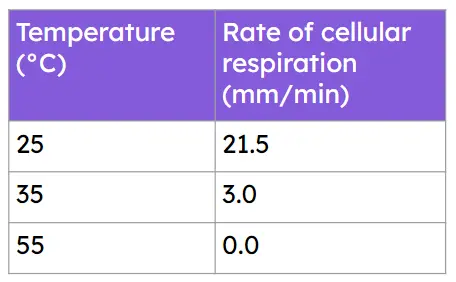Myths about teaching can hold you back


- Year 11•
- Edexcel•
- Higher
Explaining the effect of temperature on the rate of cellular respiration
I can analyse data collected from a respirometer, calculate the rate of cellular respiration, and explain the effect of temperature on the rate.


- Year 11•
- Edexcel•
- Higher
Explaining the effect of temperature on the rate of cellular respiration
I can analyse data collected from a respirometer, calculate the rate of cellular respiration, and explain the effect of temperature on the rate.
These resources will be removed by end of Summer Term 2025.
Switch to our new teaching resources now - designed by teachers and leading subject experts, and tested in classrooms.
These resources were created for remote use during the pandemic and are not designed for classroom teaching.
Lesson details
Key learning points
- Calculate the rate of respiration by dividing the distance moved up the capillary tube of a respirometer by the time.
- Use appropriate units for the rate of cellular respiration.
- Compare the rate of respiration in small organisms at different temperatures.
- Describe trends in the data.
- Use ideas about enzymes and rate of chemical reactions to explain the effect of temperature on the rate of respiration.
Keywords
Rate - A measure of how much change occurs per unit of time.
Cellular respiration - An exothermic chemical process that transfers energy for life processes, using glucose as fuel.
Respirometer - Apparatus used to measure the rate of respiration in small organisms.
Enzyme - A biological catalyst.
Denature - When bonds in an enzyme molecule break and the molecule changes shape.
Common misconception
Not appreciating that increasing temperature up to the optimum has a different effect on rate than increasing temperature above the optimum.
The effects on rate of increasing temperature up to and beyond the optimum are explained.
To help you plan your year 11 biology lesson on: Explaining the effect of temperature on the rate of cellular respiration, download all teaching resources for free and adapt to suit your pupils' needs...
To help you plan your year 11 biology lesson on: Explaining the effect of temperature on the rate of cellular respiration, download all teaching resources for free and adapt to suit your pupils' needs.
The starter quiz will activate and check your pupils' prior knowledge, with versions available both with and without answers in PDF format.
We use learning cycles to break down learning into key concepts or ideas linked to the learning outcome. Each learning cycle features explanations with checks for understanding and practice tasks with feedback. All of this is found in our slide decks, ready for you to download and edit. The practice tasks are also available as printable worksheets and some lessons have additional materials with extra material you might need for teaching the lesson.
The assessment exit quiz will test your pupils' understanding of the key learning points.
Our video is a tool for planning, showing how other teachers might teach the lesson, offering helpful tips, modelled explanations and inspiration for your own delivery in the classroom. Plus, you can set it as homework or revision for pupils and keep their learning on track by sharing an online pupil version of this lesson.
Explore more key stage 4 biology lessons from the Aerobic and anaerobic cellular respiration unit, dive into the full secondary biology curriculum, or learn more about lesson planning.

Equipment
Content guidance
- Risk assessment required - equipment
Supervision
Adult supervision required
Licence
Prior knowledge starter quiz
6 Questions
Q1.What kind of cellular respiration is used to produce alcoholic drinks?

Q2.Bacteria that produce lactic acid when they respire are used in the production of yogurt from milk. What can you conclude about the amount of oxygen dissolved in milk?
Q3.The simple respirometer shown in the diagram is used to investigate the effect of temperature on the rate of cellular respiration. Match each variable to its correct example.
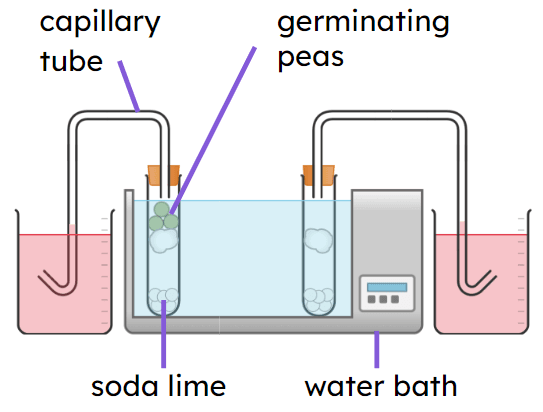
dependent variable -
the distance moved by the coloured water
independent variable -
the temperature of the water bath
control variable -
the number of germinating peas
Q4.When using this type of respirometer, the water moves up the capillary tube because the pressure inside the test tube falls. Why does the pressure in the tube fall?

Q5.A student plans to use a respirometer to investigate the effect of temperature and amount of glucose on the rate of respiration. The investigation will not produce valid results. Why?
Q6.A student used the respirometer shown. After 5 minutes at 25 °C, the coloured water moved 8 mm towards tube A and 2 mm towards tube B. How many mm has the water moved because of cellular respiration?
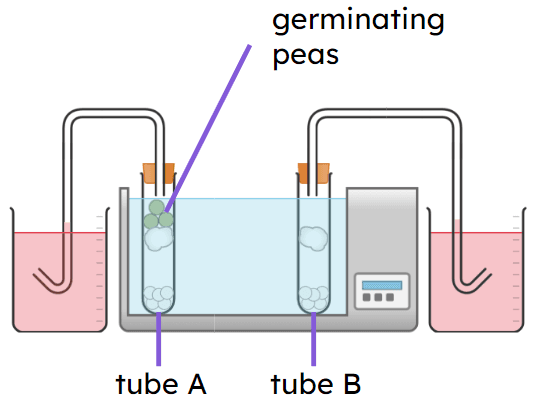
Assessment exit quiz
6 Questions
Q1.The respirometer shown is used to measure the rate of respiration. What units would the rate of respiration be measured in?

Q2.The following table shows results from a respirometer experiment. What conclusion can be drawn from these results?
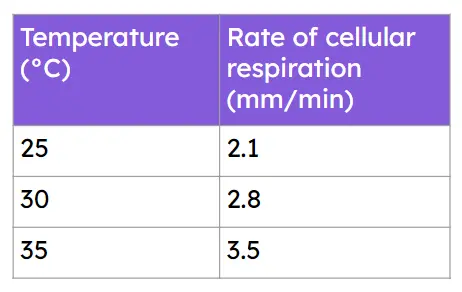
Q3.The following table shows results from a respirometer experiment. Which statement about the data is true?
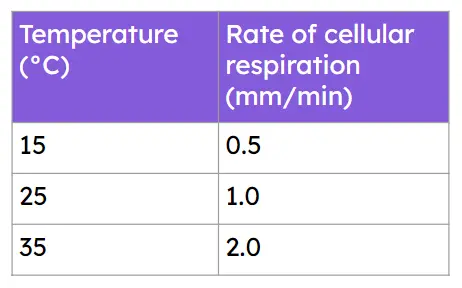
Q4.Enzymes work as catalysts because the substrate precisely fits into part of the enzyme molecule called the active site. Scientists use the and key model to describe this precise fit.
Q5.Which of these is the best explanation of why the rate of cellular respiration increases with temperature?
Q6.At 55 °C, the temperature is so high that it breaks bonds in the enzyme molecule, changing its 3D shape. The enzyme is and no longer works.
